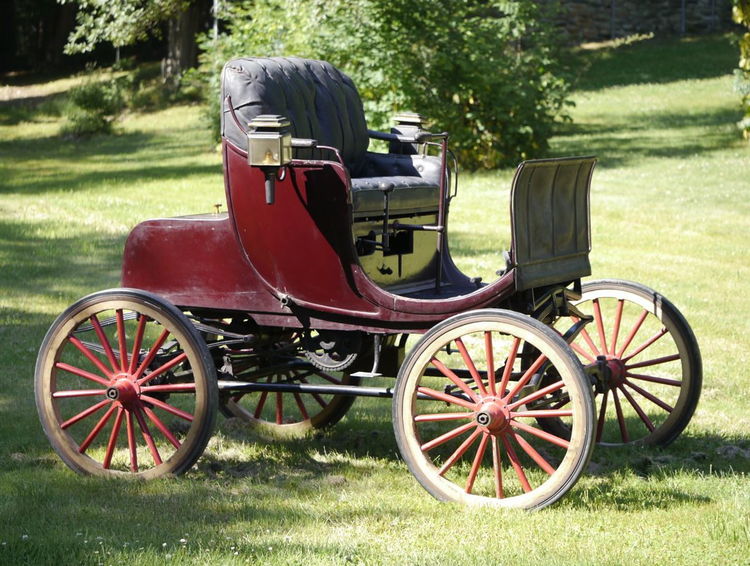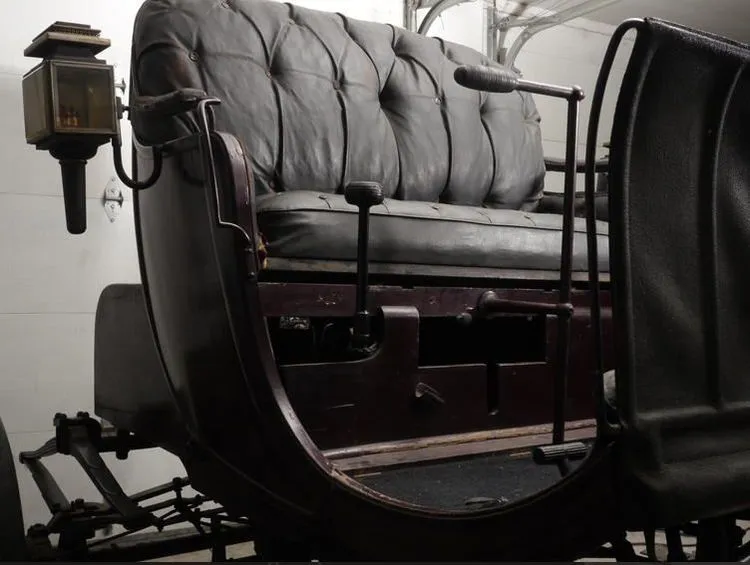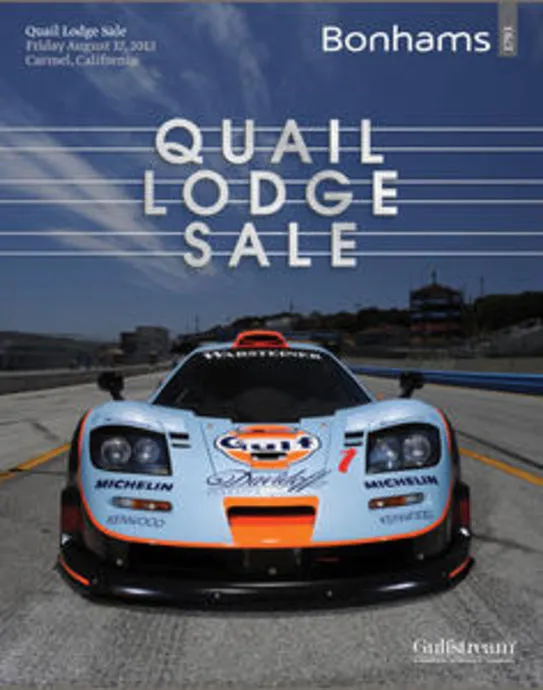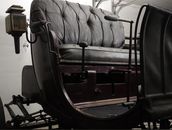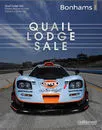The World's Oldest Four Cylinder Car Being Auctioned at Quail in Monterey
This ad is marked as Sold
Description: |
|
| The world's oldest four-cylinder car, the oldest American car ever offered at auction, the oldest American gasoline car in private ownership. The first Buffum automobile produced, Buffum family ownership for nearly 40 years, ex- Princeton Auto Museum collection, 1895 Buffum Four-Cylinder Stanhope Chassis no. 1BUFFUM * World's first four-cylinder automobile * Numerous technological firsts * Known history since construction * An icon of the Dawn of American Motoring * First time offered publicly H.H. Buffum, during his involvement with the automobile, designed and produced some of the most ambitious, early automobiles ever seen in this country. In a period spanning just 13 years, about 70 truly remarkable machines were built. For a man who made so few cars, Buffum achieved groundbreaking results: he produced the first American four-cylinder car, production or otherwise, the first cataloged production American race car and the world's first production V8 automobile. Buffum began work on his first automotive design, the machine offered here, in 1894. The car was completed the following year in Massachusetts, where Buffum had moved to from the West Coast for the purpose of producing machinery for the burgeoning shoe industry in the Northeast. Buffum was primarily a designer and producer of complex machines for the automation of shoe production. In fact, he had secured numerous patents for his machinery, developed a successful sprinkler head design as well as sewing and nailing machines. New England in the 1890s was a center of industrial precision metal working. Factories producing guns, sewing machines and bicycles flourished; and the area was filled with skilled artisans and well educated engineers. This atmosphere of progress and manufacturing resources ignited the idea of mechanized transport in a number of individuals. The Duryea brothers were hard at work on the concept in the early 90s and Hiram Percy Maxim began to develop his first multi-cylinder engine in the same period. That same idea, too, was taking shape with H.H. Buffum. The motor was initially what caught Buffum's interest. He did not gravitate to the obvious idea of grafting a stationary type engine to a carriage, but had a vision for a more sophisticated motor that would have the flexibility and compactness necessary for an automobile. Buffum designed an in-line four-cylinder engine which, of moderate size, was based on a cast iron crank case with individual cylinders. Individual detachable heads with push rod operated and atmospheric over-head valves were fitted to the cylinders. Ignition was by make and break and the intake was a primitive mixing valve. The dual exhaust system flowed through distinctive twin canister muffler and cooling was provided by a large vented water tank (boiling tank) with individual piping for each cylinder. The construction of the motor was largely fabricated but with a number of major castings. Although it looked highly advanced for its day, Buffum employed many of the accepted technologies of the period. With the motor complete, Buffum then needed an appropriate chassis to mount it in. For this Buffum sought the assistance of local carriage maker George Pierce, who fabricated a well made and surprisingly elegant chassis for Buffum's design. The tubular frame cradled the transversely mounted engine in castings mounted on the sides of the crank case. The motor tucked nicely under the seat, leaving plenty of space for the "boiling tank" cooling system, and the transverse mounting made for a convenient starting handle placement outside the car. The motor's output was fed by chain to the two-speed planetary transmission. Like most pioneer American cars, it was likely a modified unit from belt drive machinery as employed by Duryea. Finally the chassis was finished off with an elegant Stanhope body, likely also supplied by Pierce, which resulted in a car of refined elegance rather than a primitive prototype that was thrown together. The new Buffum car sported tiller steering, chain drive to the rear axle and innovative, cleverly designed controls. The gear change lever came out of the seat fall area and its leather knob rotated to operate the throttle. The distinctive leather knob, thought to be derived from a shoe hammer, was a distinctive touch and appeared also on later Buffum models. A series of pedals operated the brakes and reverse gear and the final drive, by chain and no differential, was fitted to the axle although the rear wheels were driven by ratchet to eliminate the need. Like many other pioneering builders Buffum was quite secretive of his advancements, and used his car around town only sparingly when it wasn't kept hidden away for fear that someone would steal Buffum's hard-earned designs and innovation. The car did spark interest locally, however, and Buffum began to be approached with requests for automobiles. Prior to 1900 he hand-made six cars, each with evolving design – likely in Buffum's spare time as he had a thriving business to look after! Photos exist of a subsequent early prototype. The design, although it appears to employ the same engine, has progressed to a different transmission and drive system. One of Buffum's early automotive patents is for a drive system quite similar to the one in the photo. The car also shows the addition of a "snake" radiator to supplement the inefficient boiling tank. A period photo shows car number one early in its life with a set of light pneumatic carriage type wheels and a slightly different steering tiller than the prototype. Undoubtedly car number one was used to test other ideas and concepts in the early years of its life. Though always being more interested in the challenges of design, Buffum set himself up for automobile production in 1900 and manufactured a handful of cars mainly for local residents in this early period. By 1901, Buffum was making a serious play at the auto business, introducing a four-cylinder, front engine, chain drive car. This machine resembled nothing made in the country at the time and was far more likely to be mistaken for an automobile that was French made. The design of the four-cylinder motor had changed, and the motor was now an opposed four with a center mounted flywheel. One of the many novel features was a starting handle/pedal that could be operated from the driver's seat by foot. In the years following, Buffum cars became more and more advanced. In 1903, the "Central Greyhound" 100hp eight-cylinder racing car was built to take on Winton at the Gordon Bennett Cup in Ireland. The largest and most powerful American racecar built up to that time. Although the car never made it to the event, it was demonstrated in America and a version became a catalogued model. The production Greyhound (the 80hp Model G) would gain the distinction as America's first cataloged production racing car and the first production eight-cylinder American car. In 1904, a big four-cylinder chain drive model with a cast aluminum Roi Des Belges body was the featured model. The magazine the Automobile had this to say about the Buffum hand-hammered alloy body car "one of the finest pieces of automobile construction ever shown....This car is the work of a mechanic of the class to which all makeshift is abhorrent." A V-8 powered Buffum, the first V-8 offered in a production car, was introduced for the '05 model year. By 1908 Buffum had become disenchanted with automobile production and left the Massachusetts area for New Hampshire in order to pursue an interest in powerful motor boats. He would go on to produce similarly ambitious motors for marine vessels and airplanes, most notably a twelve-cylinder, opposed marine engine and a lightweight V-12 aircraft engine. In 1914, he made a final contribution to the auto industry with the Laconia cycle car, the only vehicle of its type produced in New Hampshire, and later Buffum built the first pier at the Weirs on Lake Winnipesaukee. Buffum eventually returned to the West Coast where he died in 1933. The car offered here, the original Buffum, was never sold during Buffum's life time. As mentioned, he kept the car in the possession of a storage building to protect his patent possibilities. It was Buffum's ex-wife, Mrs. Dudley, who finally sold the car in 1934 - a year after Buffum's death. She sold it to Harry Bell, an early collector in the Boston area who had assembled a moderate collection of early antique cars, although she could not understand why someone would want to buy it. The sale of this pioneering car created quite a lot of interest in the media. The Boston Globe, as well as several other local papers, announced the sale of the 1895 car. The Buffum was then displayed for many years at the Princeton Auto Museum in Princeton, MA, an institution that was founded in the early 1930s and was one the first auto museums in the country. There are conflicting views as to whether Bell lent the Buffum to the Museum at this time or if the institution actually owned the car; however, the exclusion of the Buffum when the Princeton Auto Museum was sold to the Zimmerman Museum indicates it may have still belonged to Bell. Nevertheless, included in the car's file is a Princeton Auto Museum brochure which lists the 1895 Buffum as on display. In the 1960s the car passed between a few hands before settling with John Swann of Highland, Maryland for a number of years. Swann made the car operational and used it in a number of parades. While in his care, the Buffum became the first automobile to cross the Parallel Chesapeake Bay Bridge on its opening in 1973. Since then the car has been seldom seen and it has spent the last 20 years in a discreet private collection. In recent years the owner placed it on display at the Owl's Head Transportation Museum in Owl's Head, ME. Today the car survives in largely original condition. It looks as though the body may have been repainted many years ago, but most of the leather upholstery and dash is original. Mechanically it is well preserved and has seen only minor reversible modifications to make it reliable. The car still retains its distinctive twin exhaust mufflers, carburetor and make and brake equipment. It has not run in many years but is currently being recommissioned for the sale. Presently it survives as one of the oldest, functional American cars in existence. There are just a handful of American cars from the pre-'98 era and, of those, the majority belongs to Museum collections. When you look to American cars before 1897 you can count the number on one hand. It is unlikely that there will be an opportunity to acquire an older or more historically significant pioneering American machine than this one. It has potential to be the oldest American gasoline car to start the London to Brighton Run and it would consequently likely receive one of the lowest starting numbers. It would also be a tremendous machine for a museum collection as it has such historical significance on so many levels. This Buffum, being a 1895, four-cylinder engine and the sole surviving product of one of America's greatest automotive minds makes this an automobile of monumental importance. Estimate: US$ 250,000 - 350,000 £160,000 - 220,000 €200,000 - 280,000 |
|
Members profile: |
|
| Advertised by: | Bonhams Motor Cars USA (click here to see full profile) |
| Email: | Email Advertiser |
Ad Details |
|
| Property is | Sold |
| Garage Spaces (put 0 if this does not apply) | 0.00 |
| Price Info | No Sale at Auction .. Contact for possible private sale. |
| Type: | Classic Vehicle / Collector Vehicle, Car |
| New or Used: | Used |
| Year: | 1895 |
| Model: | Four-Cylinder Stanhope |
| Make: | Buffum |
| Price: | $350,000 USD |
| Interior Color: | Black |
| Exterior Color: | Burgundy |
| VIN #: | 1BUFFUM |
For Sale at Auction |
|
| Auction Sale? | Yes |
| Type of Auction | Phone Bidding, Internet Bidding, On-site Registration, Reserve Price, Retail Auction Event |
| Auction Date | 08/17/2012 |
| Location | Quail Lodge, Carmel, CA USA |
| Name of Auction | Bonhams Quail Lodge Sale |
| Auction Website | http://www.bonhams.com/auctions/20322/ |
Unique Sale Issues |
|
| Type of Sale | Auction Company Sale, For Sale By Owner |
Website |
|
| Website | http://www.bonhams.com/auctions/20322/lot/446/ |
| Website | http://www.bonhams.com/auctions/20322/ |
Location |
|
| View on map | |
| Address | 8000 Greens Valley Dr. |
| Suite | Quail Lodge |
| City | Carmel |
| State | CA |
| Postal Code | 93923 |
| Country | USA |
Call Me! |
|
| Phone | +1 415 391 4000 |
| Fax | +1 415 391 4040 |
| Ad id: | 60252315 |
| Views: | 6839 |


